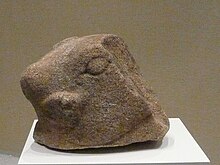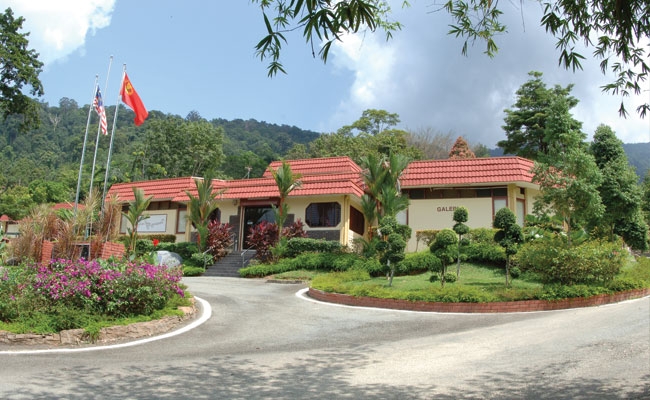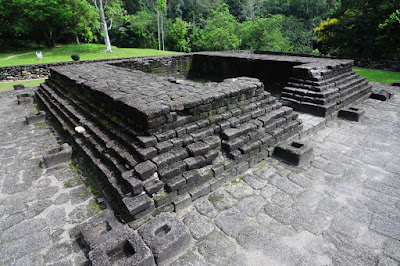This year is Visit Kedah Year 2016. Kedah Darul Aman or Kedah Abode Of Peace is one of provinces in Malaysia located in the west Malaysia not far from Penang and Langkawi. If this is the first time you heard about Kedah, why don't you watch this tourism commercial by Visit Kedah 2016.
Have you heard about Candi Lembah Bujang/Bujang Valley Temple in Kedah, Malaysia? This is an unpopular, hidden secret of south east asia. Many ruins in south east asia such as in Cambodia, Thailand and Indonesia were developed as tourist attraction while in Malaysia this 'area' are protected as a archeological site and museum.
Have you heard about Candi Lembah Bujang/Bujang Valley Temple in Kedah, Malaysia? This is an unpopular, hidden secret of south east asia. Many ruins in south east asia such as in Cambodia, Thailand and Indonesia were developed as tourist attraction while in Malaysia this 'area' are protected as a archeological site and museum.
The Bujang Valley or Lembah Bujang is a sprawling historical complex and has an area of approximately 224 km2. Situated near Merbok, Kedah, between Gunung Jerai in the north and Muda River in the south, it is the richest archaeological area in Malaysia.
These archaeological remains show that there was a Hindu-Buddhist polity here. In sanskrit the term bhujanga refer to serpent, thus the name itself is roughly translated into "Serpent Valley". The area consists of ruins that may date more than 2000 years old. More than fifty ancient tomb temples, called candi (pronounce "chandi"), have also been unearthed. The most impressive and well-preserved of these is located in Pengkalan Bujang, Merbok. The Bujang Valley Archaeological Museum is also located here. In the area of Bujang Valley known as Sungai Batu, excavation have revealed jetty remains, iron smelting sites, and a clay brick monument dating back to 110AD, making it the oldest man-made structure to be recorded in Southeast Asia.
Research also indicates that there was a Hindu-Buddhist kingdom here possibly as early as 110 CE. The local rulers adopted Indian cultural and political models earlier than those of Kutai in eastern Borneo, in southern Celebes or Tarumanegara in western Java, where remains showing Indian influence have been found dating from the early 5th century. Relics found in the Bujang Valley are now on display at the archaeological museum. Items include inscribed stone caskets and tablets, metal tools and ornaments, ceramics, pottery, and Hindu icons.
For the past two decades, students from universities around Malaysia have been invited for research and have done their graduate works at the Valley. Much of the historical links is still vague considering not many of the scriptures and writings survive. Even the temples did not survive the onslaught of age because their wooden roofing has rotted and withered over the past 1200 years. The museum itself is inadequate and not organized, much of the findings are elsewhere scattered from Museum Negara to Singapore (which once formed a part of Malaysia). Folk stories and oral history also provide place for a magnificent kingdom of jewels and gold. Outside peninsular and insular Southeast Asia, there is oral history in India that suggests the presence of golden chariots and jewels in hidden caves at Bujang Valley and Mount Jerai. Some visitors to the antiquity department at Muzium Negara has eye witness recollection of magnificent objects such as a 10 feet tall Raja Bersiung Throne and various idols and items from the Valley.
On 1 December 2013, it was reported that, a 1,200-year-old Hindu Temple at the site, identified as Candi No. 11, had been demolished by a land developer. Candi 11 was one of the most ancient of the old Kedah kingdom and was amongst 17 registered candi. In the face of public criticism, the Kedah State Government sought to deflect blame by claiming that it was powerless to do anything because the land was privately owned and further, that the site had not been gazetted as a historical site. After the controversy, the Tourism and Heritage Ministry has agreed to consider gazetting the Bujang Valley as heritage site
Before the 1970s, the research in Bujang Valley was done by western arcaheologist, the most prominent ones include H.G .Quaritch Wales, Dorothy Wales, and Alastair Lamb.
After the 1970s, local archaeologists were trained to continue the research there. With the strong support of the Malaysian Government, excavations and reconstructions of sites were done in Bujang Valley by Universiti Kebangsaan Malaysia and University of Malaysia in collaboration with The Department of Museums and Antiquity. The most prominent local archaeologist who did research in the Bujang Valley was Nik Hassan Shuhaimi Nik Abdul Rahman (Universiti Kebangsaan Malaysia) who wrote and publish countless books and articles on this topic. He introduced a periodization of the history of Bujang Valley as well as a theory which explains about the process of indigenization of the Indian Culture which formed the socio-economic make up of the polity.
Other earlier local archaeologist who significantly contributed to the research of Bujang Valley include Leong Sau Heng (University of Malaya), Mohd Supian Sabtu (University of Malaya), Kamarudin Zakaria (Museums Department), Zulkifli Jaafar (Museums Department), and Zuliskandar Ramli (Universiti Kebangsaan Malaysia). After 2008, The Centre for Global Archaeological Research (CGAR) from University Sains Malaysia, led by Mohd Mokhtar Saidin explored a new archaeological complex which reveals dozens of new sites, said to be dated from 2nd Century C.E.
Presently, a number of new researchers are being trained in local and foreign universities to continue the research in Bujang Valley in the future. They were trained in a number important sub-disciplines of archaeology which include Epigraphy, Palaeography, Hindu-Buddhist Architecture, Metallurgy, historical arcaheology, Maritime Archaeology andPalinology which will contribute immensely to future research.
History
Built in 6th century A.D, Candi Bukit Batu Pahat is the most well-known ancient Hindu temple found in Bujang Valley, Kedah, Malaysia.
Claudius Ptolemaeus (Greek: Κλαύδιος Πτολεμαῖος; c. 90 – c. 168), known in English as Ptolemy, was a Greek geographer, astronomer, and astrologer who had written about Golden Chersonese, which indicates trade with India and China has existed since the 1st century AD.
As early as the 1st century AD, Southeast Asia was the place of a network of coastal city-states, the centre of which was the ancient Khmer Funan kingdom in the south of what is now Vietnam. This network encompassed the southern part of the Indochinese peninsula and the western part of the Indonesian archipelago. These coastal cities had a continuous trade as well as tributary relation with China from very early period, at the same time being in constant contact with Indian Traders. They seem to have shared a common indigenous culture.
Gradually, the rulers of the western part of Indonesia adopted Indian cultural and political models e.g. proof of such Indian influence on Indonesian art in the 5th century, i. e. an Amaravati Buddha statue found in southern Sulawesi and a Sanskrit inscription found east of Jakarta.
Three inscriptions found in Palembang (South Sumatra) and on Bangka Island, written in a form of Malay and in an alphabet derived from the Pallava script, are proof that "Indonesians" had definitely adopted Indian models while maintaining the indegenious language and social system. These inscriptions reveal the existence of a Dapunta Hyang (lord) of Srivijaya who led an expedition against his enemies and who curses those who will not obey his law.
Being on the maritime route betweenChina and South India, the Malay peninsula was involved in this trade. Contact between the peninsula with China and Southern Indian. The Bujang Valley, being strategically located at the northwest entrance of the Strait of Malacca as well as facing the Bay of Bengal, was continuously frequented by Chinese and Indian traders. Such was proven by the discovery of trade ceramics, sculptures, inscriptions and monuments dated from the 5th to 14th Century CE.
The Bujang Valley was continuously administered by different thalassocratical powers including Funan, Srivijaya and Majapahit before the trade declined.

Map showing Rajendra Chola's raid that include the Malay peninsula
In the ancient city of Tanjore in Tamil Nadu in southern India are inscriptions dating from 1030 which mention the victory of Chola kingRajendra Chola I over some kingdoms in Southeast Asia. The name of "Kadaram" is amongst the places that Rajendra claimed to have attacked. The Cholas had a powerful merchant and naval fleet in the Indian Ocean and the Bay of Bengal. However, after the raid, there has not been any evidence of political supremacy of the Cholas in the Straits of Malacca, as the kingdom of Srivijaya restored their power there soon after the attack. Three kinds of craft are distinguished by the author of the Periplus – light coasting boats for local traffic, larger vessels of a more complicated structure and greater carrying capacity, and lastly the big ocean-going vessels that made the voyages to Malaya, Sumatra, and the Ganges.
The Chola connection
Both Raja Raja Chola and his son Rajendra Chola had established maritime contacts with the Sri Vijaya kingdom. But Rajendra Chola, during an overseas expedition, conquered Kadaram and captured its king, Sri Mara Vijoyatunga Varman.
The next significant find, at a place called Takua Pa, just above the Valley, is an 8th-century CE inscription in Tamil of the Pallava king Nandivarman II with his title ‘Avani Naranan.' It refers to a merchants' guild, trading in gems that had left from Manigramam, a village near Poompuhar, to Bujang Valley. The idol and the inscriptions in Tamil are still there at Takua Pa in present-day Thailand. Takua Pa was the first port of call for the South Indian merchants. The Bujang Valley, a little south of Takua Pa, was the next important port of call. Sri Vijaya's king, Sri Mara Vijayotunga Varman, sent an embassy from Kedah to Raja Raja Chola, requesting him permission to build a Buddha Vihara near Nagapattinam in the name of his father Sri Chulamani Varman. Raja Raja Chola permitted him to build a Buddha vihara and gifted wealth and a village called Anaimangalam, near Nagapattinam, in 1006 CE, for the vihara.
There were friendly relations between the two kings, and Vimalan Agatheesvaran, an ambassador from Sri Mara Vijayotunga Varman, gifted lamps, silver kalasams and plates to theKayarohana Siva temple, near Nagapattinam. An inscription in Tamil is still available here. Another inscription talks about Kuruthan Kesavan, a chief officer of the king of Kadaram, consecrating an ‘Ardhanarisvara' and gifting Chinese gold (‘Cheena kanagam') to the same Kayarohana temple. “Raja Raja Chola had a wonderful foreign policy. He forged friendly relations with the countries of South-East Asia,” said Dr. Nagaswamy.
Kedah inscriptions

Figure of a dancer carved in high relief found at Batu Lintang, south of Kedah

Head of Nandi found in the vicinity of site 4 near the Bujang Valley

One of the six stone boxes, which were found buried beneath Candi Bukit Batu Pahat
In Kedah there are remains showing Buddhist and Hindu influences which has been known for about a century now from the discoveries reported by Col. Low and has recently been subjected to a fairly exhaustive investigation by Dr. Quaritch Wales. Dr. Wales investigated no fewer than thirty sites round about Kedah. The results attained show that this site was the location of a Hindu–Buddhist polity similar to those found in western Indonesia.
An inscribed stone bar, rectangular in shape, bears the ye-dharmma formula in Pallava script of the 7th century, thus proclaiming the Buddhist character of the shrine near the find-spot (site I) of which only the basement survives. It is inscribed on three faces in Pallava script of the 6th century, possibly earlier.
Except for the Cherok Tokkun Inscription which was engraved on a large boulder, other inscriptions discovered in Bujang Valley are comparatively small in size and probably were brought in by Buddhist pilgrimage or traders.
LEMBAH BUJANG ARCHAEOLOGICAL MUSEUM

Collections and Galleries
The Galleries and Collections in the Lembah Bujang Archaeological Museum have two main galleries which displays archaeological artifacts serving as evidence of Lembah Bujang’s existence as I: Southeast Asia’s central trading port from the 3rd to 12th century AD comprising of goods brought by Arab, Chinese and Indian traders as well as maritime traders from the Malay archipelago including exotic jungle produce like gaharu, cendana etc. II: Architecture and materialistic culture leftovers which is connected to religious faith and proving the existence of Hindu/Buddhist faith which is the practice of a portion of the society using the Lembah Bujang as an entreport in the 3rd through the 12th century AD. Items displayed are architectural designs of Hindu temples with Hindu/Buddhist features and devices which could be related to the Hindu/Buddhist faith.
Entrance Fees
Free
Transportation
By Bus: From Sungai Petani bus terminal take the Sungai Petani shuttle to Merbok
Nearby Attractions
Drive-around tour by experienced staff members for groups exceeding 10 persons if done officially. A complete archaeological collection, library and trained officers to help researchers who are interested to further their research in 7th - 12th century AD commerce and Hindu/Buddhist customs in Lembah Bujang. Recreational and recuperational facilities where visitors have the chance to enjoy the beauty of rainforest landscape in the background of the museum, as well as be enchanted by the architecture and artifacts of societies of old. Visitors will also be able to immerse themselves in the tranquility of the flowing river and lush tropical rainforest greenery laden with exotic flora and fauna which grows naturally all around the museum Approximately 60,000 people have visited the museum since the past 3 years.
Contact
Mr. Azman bin Adam (azmanadam@jmm.gov.my)
Mr. Mat Yassim @ Mohsien bin Talib (mohsien@jmm.gov.my)
Mrs. Nurul Azlida bt. Ghozali (azlida@jmm.gov.my)
Mr. Mat Yassim @ Mohsien bin Talib (mohsien@jmm.gov.my)
Mrs. Nurul Azlida bt. Ghozali (azlida@jmm.gov.my)

No comments:
Post a Comment